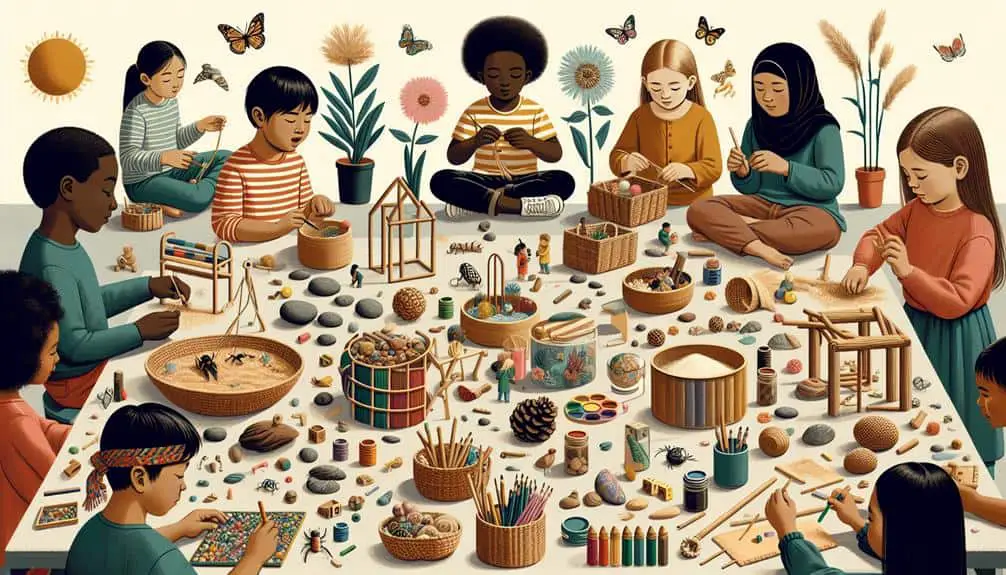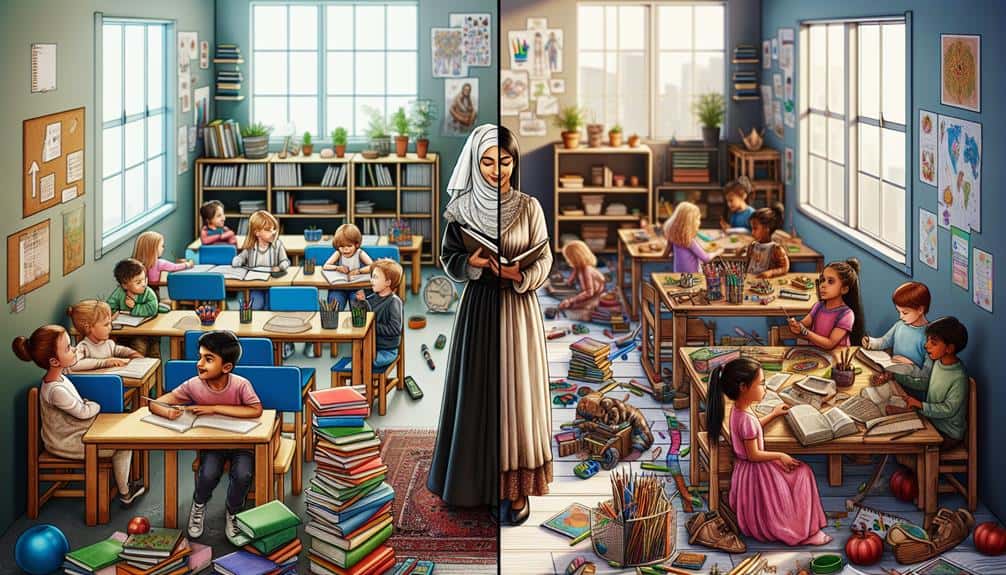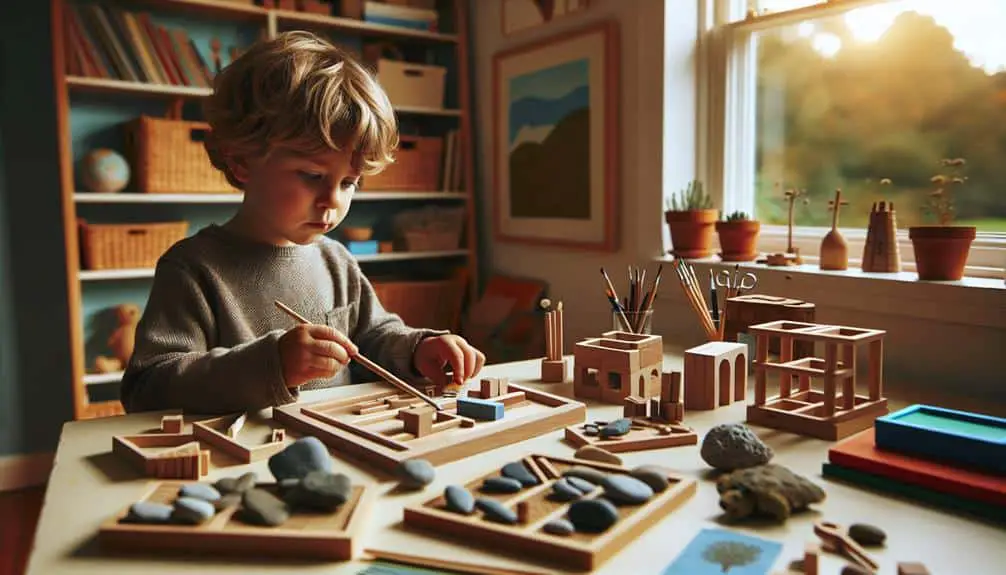Discover a child-centered approach with the Reggio Emilia method for homeschooling. Encourage your child's curiosity and autonomy through project-based activities, critical thinking, and collaboration. Create a learning environment that fosters hands-on experiences and open-ended play opportunities. Emphasize creative expression and ownership of education. Contrasting traditional homeschooling, Reggio Emilia focuses on child-led exploration rather than structured curriculum, promoting self-expression and holistic understanding. Explore resources like hands-on activities, art supplies, and documentation processes to enrich your child's learning journey. Open up a world where your child leads their education towards curiosity and competence.
Key Points
- Child-centered learning environment promoting autonomy and curiosity.
- Emphasis on hands-on, project-based activities for deeper understanding.
- Focus on creative expression, critical thinking, and collaboration skills.
- Use of open-ended play opportunities to foster holistic learning.
- Provision of inviting spaces to inspire child-led exploration and learning.
Key Principles of Reggio Emilia Approach
One of the key principles of the Reggio Emilia Approach is the belief in the child as a competent, capable, and curious learner. This philosophy emphasizes child-led learning, where children are seen as active participants in their education rather than passive recipients.
In this approach, children are encouraged to explore their interests and passions through project-based activities. These projects are often long-term, in-depth investigations that allow children to thoroughly investigate a subject matter that intrigues them. By engaging in project-based activities, children not only develop a deeper understanding of the topic at hand but also enhance their critical thinking, problem-solving, and collaboration skills.
Child-led learning in the Reggio Emilia Approach promotes a sense of ownership and autonomy in children's education, fostering a love for learning that extends beyond the classroom. Through hands-on experiences and interactions with their environment, children are able to construct their own knowledge and make meaningful connections between concepts.
This approach values the unique perspectives and capabilities of each child, nurturing a positive self-image and a lifelong passion for learning.
Implementing Reggio Emilia at Home
To implement the Reggio Emilia Approach at home, consider creating a child-centered learning environment that promotes exploration and project-based activities. Emphasize hands-on learning experiences where children can engage with materials, manipulate objects, and interact with their environment. Encourage child-led exploration by following your child's interests, allowing them to choose topics for study, and guiding them through in-depth investigations.
Provide opportunities for open-ended play, where children can express themselves creatively and experiment with different materials.
Set up inviting learning spaces within your home that are organized and aesthetically pleasing, with easy access to a variety of materials such as art supplies, natural elements, and loose parts. Create documentation panels to showcase your child's learning journey and reflections, fostering a sense of pride and accomplishment.
Foster a collaborative learning environment where children can work together on projects, exchange ideas, and learn from one another. By implementing the Reggio Emilia Approach at home, you can support your child's natural curiosity, creativity, and love for learning.
Benefits of Reggio Emilia for Homeschooling
Exploring the benefits of implementing the Reggio Emilia Approach for homeschooling can shed light on the positive impact it can have on your child's learning experience and development. One key benefit is hands-on learning, where children actively engage with materials, ideas, and the environment, fostering a deeper understanding of concepts.
Through child-led exploration, kids can investigate topics of interest, promoting a sense of autonomy and curiosity.
Another advantage is creative expression, as the Reggio Emilia Approach values the arts and encourages children to communicate their thoughts and feelings through various mediums. This emphasis on creative expression cultivates critical thinking and problem-solving skills.
Additionally, project-based learning allows children to explore topics in depth, fostering a holistic understanding of subjects and promoting collaboration with peers.
Reggio Emilia Vs. Traditional Homeschooling
When juxtaposing the Reggio Emilia Approach with traditional homeschooling, it's essential to ponder the fundamental differences in teaching methodologies and outcomes for children. Reggio Emilia emphasizes a child-centered approach that values self-expression, creativity, and collaboration, while traditional methods often follow a structured curriculum with predetermined learning objectives.
In Reggio Emilia, children are seen as capable and competent learners, encouraged to explore their interests through hands-on experiences and projects, fostering a deep understanding of concepts. On the other hand, traditional homeschooling typically relies on textbooks, worksheets, and teacher-led instruction, which may limit a child's autonomy and creativity in the learning process.
Moreover, Reggio Emilia values the importance of the environment as the 'third teacher,' where spaces are thoughtfully designed to inspire curiosity and provoke exploration. In contrast, traditional homeschooling settings may not prioritize the aesthetic and interactive elements that are integral to the Reggio Emilia philosophy.
Resources for Reggio Emilia Homeschooling
For effective implementation of the Reggio Emilia Approach in your homeschooling environment, consider utilizing a variety of resources that align with the philosophy's principles. Incorporating hands-on activities is essential to foster experiential learning and exploration. Encourage creative expression through art supplies, open-ended materials, and opportunities for imaginative play.
Child-led learning is a fundamental aspect of the Reggio Emilia Approach. Provide your child with choices and autonomy in their educational journey. Offer opportunities for them to explore their interests and guide their own learning experiences.
The documentation process is key to capturing and reflecting on your child's learning journey. Use journals, photographs, videos, and other tools to record their progress, thoughts, and discoveries. This documentation not only serves as a record but also as a way to involve your child in reflecting on their own learning process.
Frequently Asked Questions
How Does the Reggio Emilia Approach Support Children With Special Needs?
To support children with special needs, the Reggio Emilia approach emphasizes individualized accommodations within an inclusive environment. Collaborative problem solving and creative expression are key components, fostering a supportive and enriching learning experience for all students.
Can the Reggio Emilia Approach Be Adapted for Multiple Children in a Homeschool Setting?
In homeschooling, adapting the Reggio Emilia approach for multiple children involves fostering group dynamics with personalized activities. Encourage sibling collaboration while tailoring learning experiences to each child, promoting individualized growth within a shared educational journey.
Are There Specific Materials or Tools Required for Reggio Emilia Homeschooling?
To establish an ideal Reggio Emilia learning environment at home, make sure you have a variety of art materials for creative expression. Implement hands-on activities and use documentation techniques to track progress and foster reflection.
How Can Parents Assess Their Child's Progress With the Reggio Emilia Approach?
To assess your child's progress with the Reggio Emilia approach, actively engage in their learning journey. Through parent involvement, observe their individualized learning experiences, document their growth, and reflect on their development. Regularly monitor and celebrate milestones together.
What Role Do Parents Play in Facilitating Social Interactions in Reggio Emilia Homeschooling?
In the dance of education, parents hold the melody, guiding social symphonies in Reggio Emilia homeschooling. Your involvement shapes a vibrant learning environment, nurturing social skills through facilitating interactions that harmonize hearts and minds.



